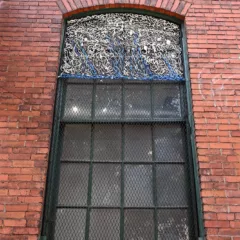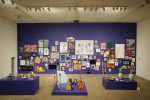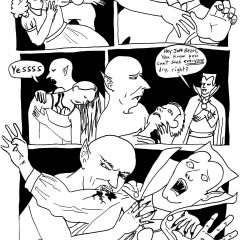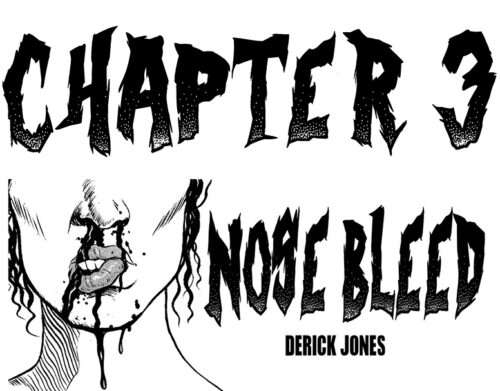H. D. Ivey’s M.A.D. (Mutual Assured Destruction) comes at a poignant moment amid negotiations between Iran and U.S. over the production of nuclear weapons. M.A.D., in case you’re not familiar, is a military strategy in which two opposing forces launch a full-scale attack against one another, resulting in the total destruction of both parties.
Heads in the sand
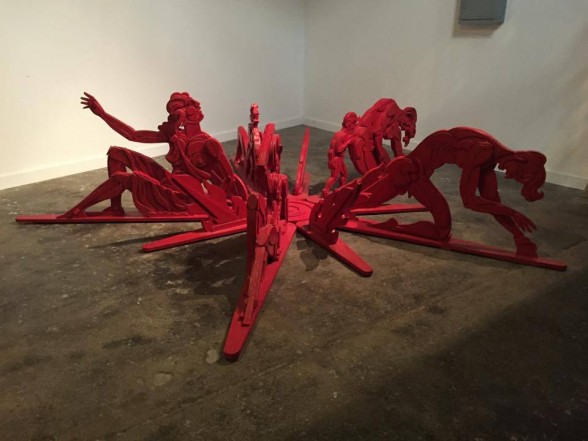
Ivey, a Texas-born, Philadelphia-based artist, constructs a satirical installation of larger-than-life wooden sculptures and drawings meant to deceive viewers with their vibrantly painted scenes, which distract from their grim underlying subject matter. Casa de Duende, a space inside the Crane Arts Building where Ivey’s works are installed, focuses on the social relevance of art and its role in contemporary culture; the gallery space augmented Ivey’s work with a scholarly lecture by Nobel Peace Prize winner Dr. Ira Helfand, an expert on nuclear weapons who spoke on July 20, 2015. The show is a collaborative initiative between Casa de Duende and Physicians for Social Responsibility.
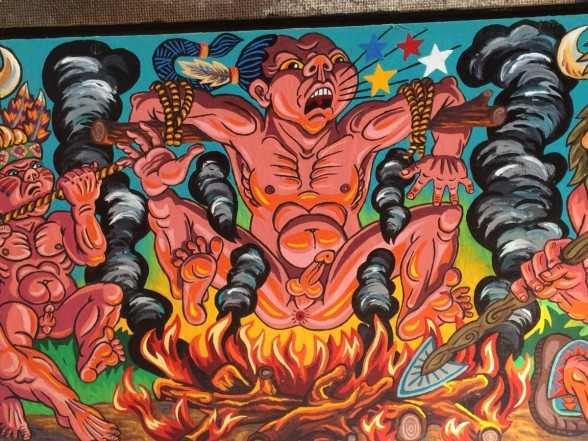
Upon first entering Casa de Duende, I was struck by the towering mass of wooden sculptures of nuclear missiles, skyscrapers, and mushroom clouds that occupies the room. Ivey sugarcoats subjects of death and despair with an intriguing fusion of Mexicana and Americana folk traditions and vignettes depicting vibrant, animated scenes chock-full of candy skulls and odes to U.S. patriotism. His decision to do so reflects the lack of concern over warheads at present among the general public in the U.S., and arguably worldwide.
Everyone loses
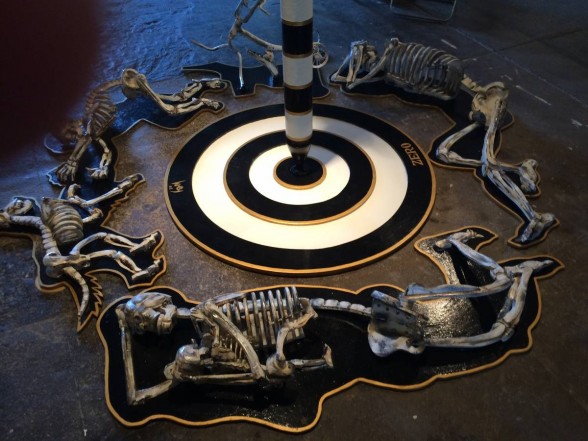
Ivey’s work leaves a lasting impression of concern for the true victims left to suffer following nuclear warfare. Amid the sculptures depicting skeletal remains and an overturned tricycle at the center of the room, it is safe to say that Ivey sees the negative impacts of these events as all-encompassing.

Ivey’s call to action
M.A.D. (Mutual Assured Destruction) marks H.D. Ivey’s first solo exhibition, featuring work from the past 27 years of his artistic career. This feat was made possible by a largely successful Indiegogo campaign that exceeded its goal with a total of $3,815 in funds raised on June 11, 2015. The tumultuous torsion Ivey achieves in his figures, sculpted in low relief, calls to mind the flat agony and despair of Picasso’s “Guernica”.

Yet, the artist depicts these scenes with rough-and-tumble, masculine cowboys in the lawless West they inhabited in days past. In the farthest corner of the gallery, a large cowboy straddles a snake with his genitals, which resemble a phallic handgun, cocked and loaded. He waits on guard–atop a podium of vibrantly painted vignettes–as a symbol paralleling the U.S. in that they both police and assert their clout frequently.
Dr. Helfand’s lecture perpetuated the dire nature of the negative impact of deploying nuclear warheads. He elucidated the climate change that would ensue and ultimately diminish global agricultural outputs. Helfand estimated that if a nuclear conflict should arise amid two countries, like the volatile situation between Pakistan and India, that global temperatures could plummet up to 1.3°C. This change, Helfand claimed, would reduce global precipitation amounts, as less water would be evaporated with the drop in temperature.
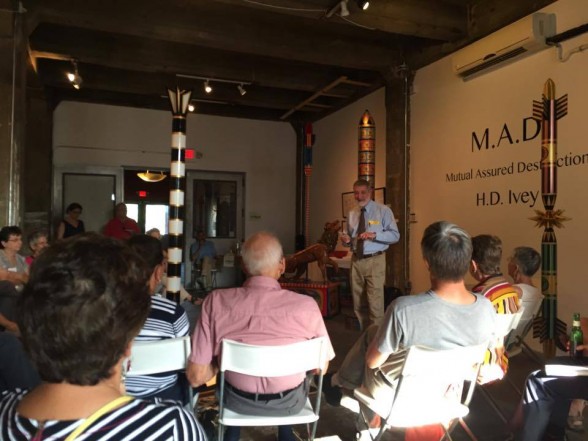
However, the aftermath would continue on for many years. For instance, it is estimated that there would be a drop of 12 percent in corn production over a 10-year span in the U.S.–during which time prices for crops such as corn, rice, and wheat would inflate, rendering starvation an even larger global issue. Countries in the Middle East, North Africa, and even Japan would greatly suffer from the rise in crop prices, as they heavily rely on imports to remain stable.
As Dr. Helfand continued his lecture, set against Ivey’s volatile sculptures, he imbued the work with a new sense of urgency. A tower to the speaker’s right depicted two missiles frozen at the moment of their tumultuous collision: a literal visualization of the conflict between Pakistan and India as highlighted by Dr. Helfand.
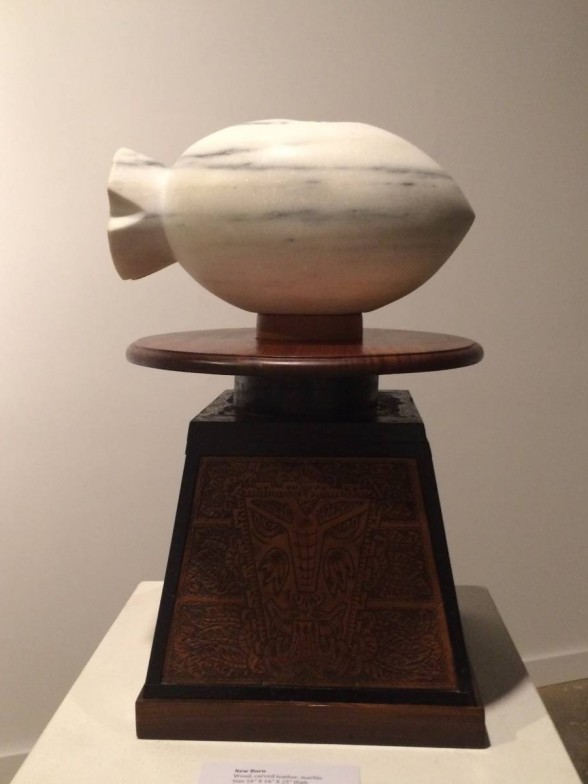
The exhibition and lecture proved to be a symbiotic experience begging viewers to remove their blinders from an easily avoidable situation–we must ban the possession of nuclear warheads. By allowing their presence on this Earth, we set ourselves up for an arms race that, if acted upon, could kill upward of two billion people after the initial detonation and the ensuing years of famine. The harsh reality shown by Ivey’s works solidifies that, any way you cut it, nuclear weapon use on a grand scale would cause everyone to suffer.
For more information on what you can do to help the cause, visit International Physicians for the Prevention of Nuclear Warfare and Physicians for Social Responsibility.
M.A.D. (Mutual Assured Destruction) by H.D. Ivey was on display at Casa de Duende, located on the first floor of the Crane Arts Building, from July 9- July 31, 2015, with a lecture by Dr. Ira Helfand on July 20, 2015.



